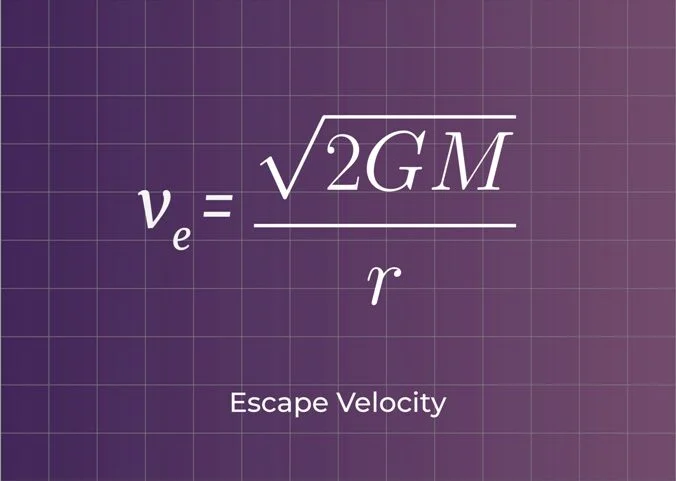Imagine you’re standing on Earth, holding a ball. You throw it upward. What happens?
- If you throw gently, it comes back down quickly.
- If you throw harder, it goes higher but still falls back.
- But if you could throw it hard enough, the ball would never return — it would escape Earth’s gravity completely.
That magic speed is called escape velocity.
1. What is escape velocity?
Escape velocity is the minimum speed an object needs to break free from a planet’s (or star’s) gravity without any extra push.
- It’s not about flying “upward” forever; it’s about having enough energy to fight gravity all the way until it weakens to nearly zero.
- If you don’t reach that speed, gravity eventually pulls you back.
2. Why not just say “escape force”?
Good question. Gravity is weird:
- It always pulls, but its strength weakens with distance.
- So, instead of a single push, you need enough initial energy to keep going as gravity gets weaker.
That’s why physicists use velocity (speed) instead of force.
3. The energy battle — how to derive escape velocity
Let’s think of it as a tug-of-war between energy.
- Kinetic Energy (energy of motion):
- Gravitational Potential Energy (binding energy to the planet):
Where:
- mmm = mass of the object
- MMM = mass of the planet
- rrr = distance from planet’s center (radius if on the surface)
- GGG = gravitational constant
For escape, you need:
Escape Velocity Derivation
Start with the total energy condition:
\[
\tfrac{1}{2} m v^2 – \frac{G M m}{r} = 0
\]
Cancel the object’s mass \(m\) (it appears in both terms):
\[
\tfrac{1}{2} v^2 – \frac{G M}{r} = 0
\]
Multiply through by 2:
\[
v^2 = \frac{2 G M}{r}
\]
Finally, take the square root:
\[
v = \sqrt{\frac{2 G M}{r}}
\]
👉 This is the escape velocity formula.
4. What this formula tells us
- Heavier planets (large MMM) → higher escape velocity.
- Bigger planets (large rrr) → lower escape velocity (because farther from center = weaker gravity).
- The object’s mass cancels out — a pebble and a rocket need the same escape speed (ignoring air).
5. Real-world numbers
Earth’s Escape Velocity
Mass of Earth:
\[
M = 5.97 \times 10^{24} \, \text{kg}
\]
Radius of Earth:
\[
r = 6.37 \times 10^6 \, \text{m}
\]
Escape velocity:
\[
v \approx 11.2 \, \text{km/s}
\]
That’s about 40,000 km/h. Faster than any plane — only rockets can do this.
🌕 Moon
- Smaller mass → weaker gravity
Escape Velocity (Example)
\[ v \approx 2.4 \, \text{km/s} \]
Astronauts on Apollo missions needed much less fuel to leave the Moon.
🪐 Jupiter
- Huge mass
Escape Velocity (Example)
\[ v \approx 60 \, \text{km/s} \]
Escaping Jupiter is extremely hard.
🕳 Black hole
- If escape velocity > speed of light, not even light escapes. That’s literally the definition of a black hole.
6. Why rockets don’t “jump” to escape velocity
Here’s a common confusion: rockets don’t blast off instantly at 11.2 km/s.
Instead:
- They gradually accelerate using continuous thrust.
- What matters is total energy — rockets supply it bit by bit with fuel.
Escape velocity is like saying:
“If you had all the speed at once and then cut the engine, would you still escape?”
So the formula is about the minimum requirement, not the actual launch process.
7. Escape velocity vs orbital velocity
Another interesting point:
- Orbital velocity = the speed to stay in a stable orbit (go around the planet).
- Escape velocity = √2 × orbital velocity at the same altitude.
On Earth:
- Low Earth Orbit ≈ 7.9 km/s
- Escape velocity ≈ 11.2 km/s
That’s why spacecraft first orbit Earth, then fire engines again to “raise” speed and escape.
8. Everyday analogy
Think of climbing a hill:
- To stand at the top, you need just enough energy to climb the hill’s height.
- If you don’t reach that height, you roll back down.
- Escape velocity is like running up the hill so fast that your momentum carries you over the peak and you never roll back.
9. Applications and significance
- Space travel: Every space mission is designed around escape velocity.
- Astrophysics: Explains why some planets keep atmospheres (Earth) while others lose them (Moon). Light gases can reach escape velocity and drift into space.
- Black holes: The ultimate escape velocity story — not even light can escape.
- Engineering: Helps determine fuel needs, rocket design, and interplanetary trajectories.
10. Key takeaways
- Escape velocity is the minimum speed to break free of gravity.
- Formula:
Escape Velocity Formula
\[ v = \sqrt{\frac{2 G M}{r}} \]
- Depends on planet mass and radius, not object mass.
- Earth’s escape velocity ≈ 11.2 km/s.
- Black holes form when escape velocity exceeds light speed.
Closing thought
Escape velocity is more than just a number; it’s a reminder of how tightly planets hold onto everything. It shows the link between gravity, motion, and energy. From tossing a stone in your backyard to studying black holes, the same principle applies: if you’ve got enough speed, you can break free.


